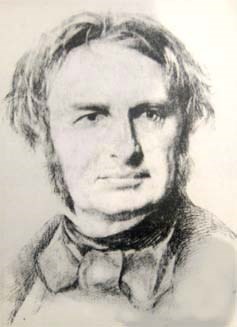
Springfield Armory NHS, US NPS
THE ARSENAL AT SPRINGFIELD
This is the Arsenal. From floor to ceiling, When the death-angel touches those swift keys! There were no need of arsenals or forts:
A Critical Overview The critical reception of Longfellow has changed over time. When his poems were published during his life, he was revered for them. His inspirational verses and folk themes struck a chord with audiences in both America and Europe, both of which were undergoing rapid change. However, after his death in 1882, his reputation was not as good, and it has been a constant debate since then as to whether or not Longfellow is a great poet. “The Arsenal at Springfield” was originally published in Graham's Magazine in May 1845; it was reprinted at the end of 1845 in The Belfry of Bruges and other Poems, a volume that technically has a copyright date of 1846. As for the poem itself, it is widely known that the poem was not Longfellow's idea. As Cecil B. Williams notes in his 1964 book, Henry Wadsworth Longfellow, the poet's second wife, Fanny, was "at least partly responsible" for the writing of the poem. As Williams explains, on the Longfellows' "wedding journey in 1843, they visited, among other places, the arsenal at Springfield, Massachusetts, with the result, Fanny said, that 'I urged H. to write a peace poem.'" Likewise, as Thomas Wentworth Higginson notes in his 1902 book, Henry Wadsworth Longfellow, Fanny sometimes "suggested subjects for poems." Fanny was not the only inspiration for the poem, however. As Higginson notes, on the trip to the arsenal, Longfellow and his wife were also joined by "Charles Sumner, just then the especial prophet of international peace." Sumner was a noted crusader for peace, and, as George Lowell Austin notes of the poem in his 1888 book, Henry Wadsworth Longfellow: His Life, His Works, His Friendships, a large influence on the poem. Austin, who had known Longfellow, recounts a conversation in which the poet told him that "The Arsenal at Springfield" "was suggested by reading Mr. Sumner's eloquent address on 'The True Grandeur of Nations.'" As for the poem itself, critics have given it mixed reviews. Some, like Edward Wagenknecht, liked the poem. In his 1986 book, Henry Wadsworth Longfellow: His Poetry and Prose, Wagenknecht calls it an "admirably constructed poem" and says that it "is perhaps Longfellow's most effective plea for peace." However, others, like Newton Arvin, in his 1855 book, Longfellow: His Life and Work, have faulted the poem somewhat. Says Arvin, the poem "is only half successful if only because the anti-war theme is developed so fully in direct rhetorical terms." Still, in the end, Arvin approves of the poem, since it "takes off from a fine image — the burnished gun-barrels at the Arsenal rising to the ceiling like the pipes of a huge and ominous organ." Many other critics have been struck by the vivid imagery of the war organ. In 1916, during World War I, George Hamlin Fitch notes in his essay, "Longfellow: The Poet of the Household," that the poem is "an eloquent plea for peace." In addition, citing the current state of affairs in the world, Fitch says that Longfellow's verses "have special force at this time when more than half the civilized world is engaged in the most destructive war ever known." However, not all critics praised the poem. The most scathing review comes from George Saintsbury, whose 1933 essay, "Longfellow's Poems," notes that while he likes many of Longfellow's verses, he did not like "The Arsenal at Springfield." Says Saintsbury, the poem "is a piece of mere claptrap, out of harmony with some of his own most spirited work, and merely an instance of a cant common at the time." Sources Arvin, Newton, Longfellow: His Life and Work, Atlantic Monthly Press, 1963, p. 75. Austin, George Lowell, Henry Wadsworth Longfellow: His Life, His Works, His Friendships, Lee and Shepard Publishers, 1888, pp. 294 – 95. Fitch, George Hamlin, "Longfellow: The Poet of the Household," in Great Spiritual Writers of America, Paul Elder and Company, 1916, pp. 58 – 67. Higginson, Thomas Wentworth, Henry Wadsworth Longfellow, Houghton, Mifflin and Company, 1902, p. 173. Longfellow, Henry Wadsworth, "The Arsenal at Springfield," in Henry Wadsworth Longfellow: Poems and Other Writings, Penguin Putnam, 2000, pp. 33 – 34. Saintsbury, George, "Longfellow's Poems," in Prefaces and Essays, Macmillan and Company, 1933, pp. 324 – 44. Wagenknecht, Edward, Henry Wadsworth Longfellow: His Poetry and Prose, The Ungar Publishing Company, 1986, pp. 76 – 77, 198, 213, 215. Williams, Cecil B., "Household Lyrics, Ballads, Odes, Elegies, Sonnets," in Henry Wadsworth Longfellow, Twayne Publishers, 1964, pp. 27, 29, 129 – 47, 192, 196. Citation: "The Arsenal at Springfield (Sources)." Notes on Poetry. Answers Corporation, 2006. Answers.com 03 Jun. 2008. http://www.answers.com/topic/the-arsenal-at-springfield-poem-8
|
Last updated: February 26, 2015
